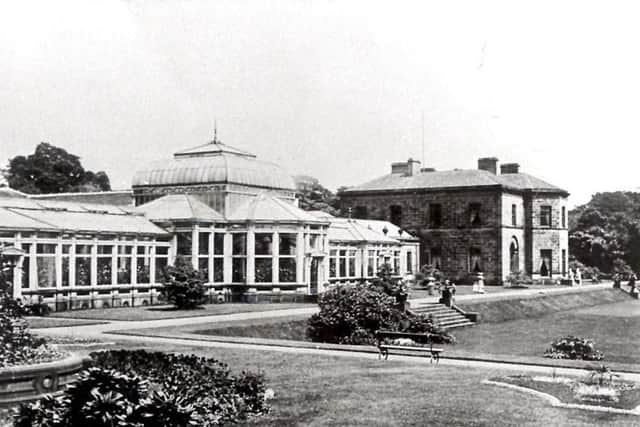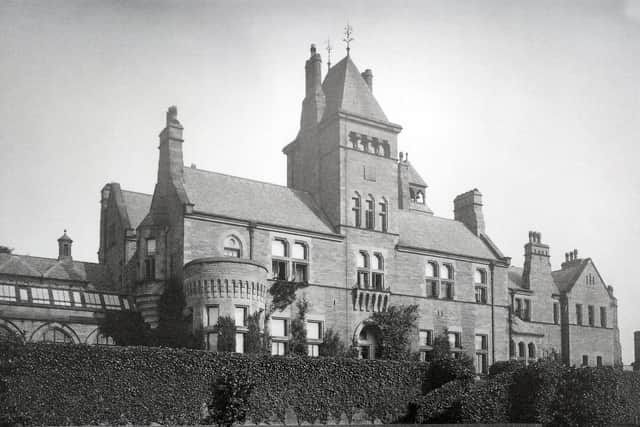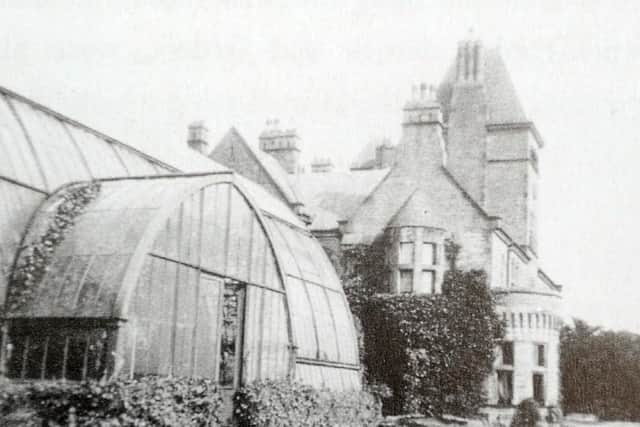The tragic fates of Yorkshire's lost country houses


Yorkshire's most prominent country houses were symbols of their Georgian and Victorian owners' wealth, power and political influence, but as the 20th century progressed they became less relevant and more difficult to maintain.
Advertisement
Hide AdAdvertisement
Hide AdReforms to the House of Lords meant the power of hereditary aristocratic peers was diminished, and they no longer needed a large seat to cement their clout.


Death duties left relatives with crippling taxes to pay when an incumbent duke, earl or baronet died, often requiring the sale of smaller estates to keep a primary residence in the family.
Many male heirs were killed in the world wars, and the damage caused to country houses by requisitioning - many were used as army barracks, hospitals or billets - left some grand mansions beyond repair.
From the 1950s, social change led to the marginalisation of country houses - they were seen as relics of a restrictive society, and it became harder to find deferential staff to work in them. Many of their owners were happy to sell up and move to more manageable properties, free of the feudal responsibilities of their forebears and able to pursue modern careers.
Advertisement
Hide AdAdvertisement
Hide AdThese are some of the most fascinating lost mansions in Yorkshire.


Rounton Grange - the seat of an industrial dynasty who built the British Empire
This mansion near Northallerton was surrounded by its own model village, and was meant to stand as a symbol of the Bell family's power for centuries.
It belonged to Middlesbrough industrialist Sir Isaac Lowthian Bell, who ran the Bell Brothers business empire with his siblings John and Thomas. They owned a vast steel and iron operation which supplied metal to Britain's overseas colonies, where it was used to build bridges and railways. They had their own mines, quarries, collieries, factories and foundries and employed 47,000 men.
Advertisement
Hide AdAdvertisement
Hide Ad

Bell bought the Rounton estate with the intention of building a seat befitting a man of his wealth and status. William Morris was commissioned to design the Arts and Crafts drawing room.
Sir Isaac died in 1904, and his relatives faced a struggle to keep the enormous mansion running, eventually moving into nearby Mount Grace Manor by the 1920s. The house was requisitioned during the world wars, and suffered damage after being used as a home for evacuees and Italian prisoners. In 1931 Sir Isaac's son Hugh died, and Hugh's son Maurice then passed away in 1944, leaving substantial death duties to be paid.
The Bells tried to sell the house, but were unable to do so and the National Trust turned down the opportunity to take it on. By 1954, it had been demolished, although the estate land was still in the hands of the family, who moved to Arncliffe Hall.
Advertisement
Hide AdAdvertisement
Hide AdRounton's walled kitchen gardens are now home to a plant shop and the model villages of East and West Rounton are still thriving communities.
Stanwick Hall - the forgotten estate of one of England's most powerful families
Stanwick, near Richmond, was the Yorkshire estate of the Dukes of Northumberland, whose primary seat was at Alnwick Castle. They had five grand country houses, and eventually could not afford to maintain all of their properties.
The house was in the Smithson family for centuries until Sir Hugh Smithson married the daughter of the Earl of Northumberland, who had no male heirs, in the 1700s. Hugh then inherited the earldom and adopted the family name of Percy, which the Dukes still use to this day. He received the dukedom from King George III in 1766.He didn't neglect Stanwick when he left for Alnwick, commissioning a major renovation of the house and adding new stables and gardens, and it became a family home for younger sons of the incumbent dukes.From 1865, the fourth duke's widow Eleanor Percy lived at Stanwick. She was a passionate horticulturalist and by the end of her life there were seven acres of formal gardens and 20 acres of pleasure grounds. She died in 1911, and afterwards the house was leased to tenants. It was a hospital during World War One, but the death of the seventh duke in 1918 left it in a precarious position.
Advertisement
Hide AdAdvertisement
Hide AdThe family reviewed their estates - Alnwick had been their seat for 700 years, Syon Park was their necessary London base, Keilder Castle in Northumberland was their hunting lodge and Albury Park in Surrey was their country residence in the south. They put Stanwick, deemed surplus to requirements, up for sale in 1921, and the estate farms and cottages were sold. But a buyer couldn't be found for the house, and much of the furniture was removed and sold to American museum collections.
A Northallerton timber merchant called Tim Place eventually bought Stanwick, and sold it on again for demolition. By 1932 it had vanished.
The foundations are still visible on aerial photos, and the old stables were converted into a house which still stands. Other estate buildings are intact and the kitchen garden has become a lawned area.
Warter Priory - the shipping merchant's mansion with splendid gardens
Advertisement
Hide AdAdvertisement
Hide AdWarter Priory, near Pocklington, was demolished in the 1970s, unlisted and thus unprotected. It dated from the 17th century, and in the 1830s became known as Warter Priory after the old Augustinian priory that once stood in the village. It was the seat of the Lords Muncaster, who in the late 1800s built corner towers, an entrance tower and a baronial hall.
The fifth and last Lord Muncaster sold the house to Hull shipping magnate Charles Wilson in 1878, and Wilson later became Lord Nunburnholme. He added a great hall, a three-storey clock tower and a grand marble staircase. The house now had over 100 rooms, including 30 bedrooms.
Wilson died in 1907, and his widow remained at Warter until the 1920s. In 1929 she sold it to George Ellis Vestey, who retained the staff and maintained the renowned gardens. After his death the estate was sold to the Marquis of Normanby in 1968 and was back in aristocratic hands.
Advertisement
Hide AdAdvertisement
Hide AdThe Marquis intended to use Warter as a shooting lodge, as his main estate was at Musgrave Castle. The contents were auctioned off and he tried and failed to find a tenant.
In 1972, the house was demolished, the famous gardens bulldozed and the lake filled in with rubble.
In 2018, Ebuyer and Wren Kitchens millionaire Malcolm Healey applied for permission to build a new luxury home on the site of the old mansion and restore the parkland.
Crow Nest - the family home with a Gentleman Jack connection
Advertisement
Hide AdAdvertisement
Hide AdCrow Nest was a mansion built for a Halifax industrial family - the mill-owning Walkers - in 1775, and it was their seat for 200 years. One of the daughters was Ann Walker, the same-sex partner of Anne Lister, whose life has been dramatised in the the BBC series Gentleman Jack. Ann inherited the estate after the death of her parents and brother.
However, the house is probably more famous as the home of Sir Titus Salt, the Bradford mill baron who rented it between 1844 and 1858 before he was evicted to allow Ann's brother to move in.
He moved to Methley Hall, near Leeds, but never lost his love for Crow Nest, and in 1867 seized his chance to buy it when the Walkers put it on the market. He built the boating lake and island and lived there until his death in 1876.
Advertisement
Hide AdAdvertisement
Hide AdSir Titus grazed alpacas and llamas on the lawns and the renowned explorer Dr David Livingstone visited the house. He hosted lavish birthday parties for thousands of guests.
After his death, Crow Nest had several owners, and during World War Two it was used to billet German and Italian prisoners of war. It subsequently fell into ruins.
After it was demolished in the 1950s, part of the estate land was used to build a golf course, and the old boathouse is still part of the club's grounds.Scriven Hall - the house mired in scandal which burned to the ground
A fire could devastate a country house and render it impossible to rebuild.
Advertisement
Hide AdAdvertisement
Hide AdThat was the fate of Scriven Hall, the Knaresborough home of the Slingsby baronets. In 1869, Sir Charles Slingsby died in a bizarre hunting accident when he and five other riders were crossing the River Ure on a raft. Their horses panicked, the raft capsized and all of the men drowned. He had no heirs and the estate passed to his sister, whose husband adopted the Slingsby name.
The estate's downfall came in even stranger circumstances, when in 1916 the current baronet and his American wife found themselves unable to have a child. They travelled abroad and returned with a baby whom they tried to have recognised as a legal heir. The unsuccessful court battle bankrupted the family and the estates were broken up and sold. Scriven Hall was then burned to the ground in 1952. The stables and coach house remain and have been converted into homes, and the main gates can still be seen.
Gatherley Castle - the mansion erased in the name of progressThe last remnants of this 19th-century mansion near Catterick fell victim to the building of the A1, which removed the last traces of it from the landscape. Gatherley was built around 1830-40, and its Victorian owner was Henry de Burgh-Lawson. In 1900, it was bought by the daughter of Darlington ironmaster William Barningham, who was unmarried, with her inheritance after his death. Barningham owned the largest ironworks in the north of England and supplied railways in India, Russia and America. After Mary Barningham's death in 1915, the contents were sold and the great house stood empty.
Advertisement
Hide AdAdvertisement
Hide AdIn World War Two, it was used to house prisoners of war and a searchlight battery. In 1963, the land was purchased by developer Edgar Lawson, who ordered the castle's demolition. Its two entrance lodges, North and South Lodge, initially remained in woodland alongside the Great North Road, but in 2016 they had to be demolished to allow the A1 to be upgraded to motorway standards.
The Rookery - the unwanted mansion that became a boarding school
The Rookery was a gothic mansion in Bishopdale that was home to the Lodge family for more than a century. It was converted into an imposing country house in 1874 by Robert Lodge, a self-made man who became the main landowner in the area.
Robert's only son John was killed in World War One, and the house then passed to his married daughter Elizabeth. In 1920, Elizabeth died and her son Matthew decided to sell the house, eleven farms and other estate buildings. The Rookery became a farmhouse, and during World War Two it was a boarding school for evacuee girls. It was later used as a youth hostel.
Advertisement
Hide AdAdvertisement
Hide AdIn 1952, problems with its upkeep led to a demolition order being issued, and The Rookery was razed with explosives. The coach house survives and today is used as a holiday let. A clump of cyprus trees, which germinated from one of the original species that escaped felling, marks the spot where the house once stood.
Milner Field - the 'cursed' house which brought tragedy to its owners
Milner Field in Saltaire was a gilded mansion and a symbol of industrial might. It was built for the son of mill baron Sir Titus Salt in Shipley Glen in 1873, overlooking the valley where the family's wool empire was based.
Advertisement
Hide AdAdvertisement
Hide AdIt had an octagonal kitchen based on Glastonbury Abbey's, an orangery, a billiard room decorated with medieval court scenes, a croquet lawn and an 81ft domed glasshouse. The then-Prince of Wales, the future King Edward VII, visited as did Princess Beatrice, the youngest daughter of Queen Victoria.
But tragedy struck when Sir Titus Jnr died in the billiard room in 1887, having been diagnosed with a heart condition two years earlier. By this point, the business was struggling - exports to America were affected by steep tariffs, and changing fashions meant there was less demand for wool. Badly-judged investments in mining and iron production in America exacerbated the financial difficulties.
The Salts Mill empire and Milner Field passed into the hands of Sir James Roberts, a self-made wool baron from Haworth who began working in mills at the age of 11. He was initially successful in running the business, but the 'curse' of Milner Field seemed to dog his family.
Advertisement
Hide AdAdvertisement
Hide AdThree of his four sons died in just a 14-year period between 1898 and 1912; the eldest, William, of pneumonia aged 24, the second, Bertram, of a nervous illness aged 36 and the youngest, Jack, drowned while on holiday in Ireland as a child. The surviving son, Harry, was badly injured in the First World War, and a nurse whom he had met in hospital and married died in the global influenza pandemic while pregnant.
Sir James's daughter Alice had eloped with medical student Norman Rutherford, the son of a local doctor in Shipley, in 1902 and married him in Scotland. He later became a decorated war hero, but in 1919 he shot and killed Alice's alleged lover, Major Miles Seaton. He was found guilty and sent to Broadmoor psychiatric hospital.
Bertram had four children at the time of his death, after which his brother Harry took over the management of the mill until he was conscripted into the army. He never returned to the business after his war injury and retired to a farm in Jersey. Bertram's eldest son, James Denby, inherited the business and baronetcy.
There were several unusual and premature deaths among the families who subsequently lived at Milner Field, and the house became difficult to sell or let as its ghoulish reputation grew.
Advertisement
Hide AdAdvertisement
Hide AdErnest Gates moved in in 1923, but lost his wife to illness just weeks later. Two years later, he died of blood poisoning after cutting his foot.
The final owner, Arthur Remington Hollins, took up residence in 1925 - both he and Gates had been managing directors at Salts Mill. His wife Anne died of pneumonia at 43 less than a year later, and three years later Arthur died on holiday from an irritation of the gall bladder.
The house was abandoned by 1930 and never occupied again. It was even raided for building materials to repair the mill, and during the Second World War was used by the Home Guard for grenade training.
It was demolished in the 1950s, although many locals struggle to remember exactly when. Traces of the mosaic floor from the giant conservatory can still be seen, and the entrances to the cellars. The site of the mansion is completely overgrown.
One of the entrance lodges, North Lodge, survives and has been restored. The model farm established by Sir Titus Jnr also remains operational.